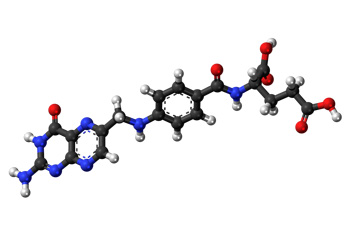Scientists discover the clearest mechanistic link yet between folic acid and birth defects, which helps explain why folic acid dietary supplements don't prevent all neural tube defects.
 The folic acid molecule.It has been known for several decades that folic acid supplementation dramatically reduces the incidence of neural tube defects, such as spina bifida and anencephaly, which are among the most common birth defects. In some populations, folic acid supplementation has decreased neural tube defects by as much as 70 percent.
The folic acid molecule.It has been known for several decades that folic acid supplementation dramatically reduces the incidence of neural tube defects, such as spina bifida and anencephaly, which are among the most common birth defects. In some populations, folic acid supplementation has decreased neural tube defects by as much as 70 percent.
Researchers have discovered that the lack of a critical enzyme in the folic acid metabolic pathway leads to neural tube birth defects in developing embryos.
However, scientists still do not fully understand how folic acid decreases neural tube defects, or why folic acid supplementation does not eliminate birth defects in all pregnancies.
“Now, we’ve found that mutation of a key folic acid enzyme causes neural tube defects in mice,” said Dean Appling, professor of biochemistry in the College of Natural Sciences. “This is the clearest mechanistic link yet between folic acid and birth defects.”
Appling and his colleagues published their research in the Jan. 8 issue of Proceedings of the National Academy of Sciences (PNAS).
The scientists made the discovery using mice that lack a gene for a folic acid enzyme called Mthfd1l, which is required for cells to produce a metabolite called formate. Embryos need formate to develop normally.
“This work reveals that one of the ways that folic acid prevents birth defects is by ensuring the production of formate in the developing embryo,” said Appling, “and it may explain those 30 percent of neural tube defects that cannot be prevented by folic acid supplementation.”
Appling said that the mice provide researchers with a strong model system that they can use to further understand folic acid and its role in birth defects in humans. In fact, humans share the same gene for the folic acid enzyme with the mouse and all other mammals. Indeed, it has recently been discovered that point mutations in that human gene increase the risk of birth defects.
[pullquote]This is the clearest mechanistic link yet between folic acid and birth defects.[/pullquote]Appling said that he and his colleagues would like to use the mouse system to begin looking for nutrients that could be delivered to pregnant mothers to prevent those neural tube defects that cannot be prevented by folic acid.
Ultimately, women could someday be screened for the gene that produces the enzyme. If they are deficient, steps could be taken to improve their chances for developing embryos free of neural tube defects through further nutrient supplementation.
Folic acid was discovered at The University of Texas at Austin in the 1940s by biochemists Esmond Snell and Herschel Mitchell. The U.S. has fortified all enriched cereal grain products with folic acid since 1996 to ensure that women of childbearing age receive adequate quantities of the vitamin.
Postdoctoral researcher Jessica Momb and graduate student Jordan Lewandowski were largely responsible for this research. Co-authors include graduate student Joshua Bryant, researcher Rebecca Fitch, researcher Deborah Surman, and Steven Vokes, assistant professor of biology.
Contact: Dean Appling, professor of biochemistry, 512-471-4796, dappling@austin.utexas.edu; Lee Clippard, media relations, 512-232-0675, clippard@austin.utexas.edu

















Comments